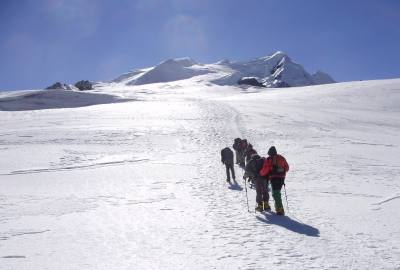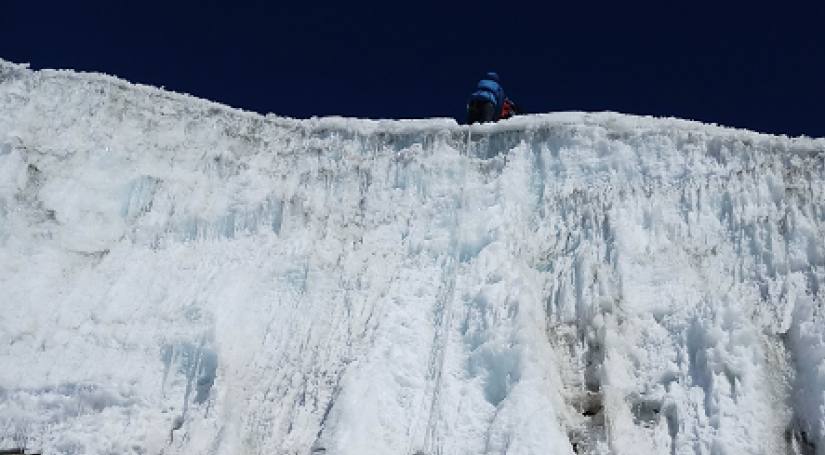Climb Lobouche East - 6119m - 19 Days
Lobouche Peak is a popular climbing destination in the Everest region of Nepal. Standing at an impressive 6,119 meters (20,075 feet) above sea level, Lobouche Peak offers a challenging yet rewarding climb for experienced mountaineers.
Key points for climbing Lobouche Peak include:
1. Technical Difficulty: Lobouche Peak is considered a technically challenging climb, requiring previous mountaineering experience and knowledge of basic climbing techniques.
2. Altitude: Climbers must be prepared for the effects of high altitude, including altitude sickness. Proper acclimatization is crucial for a successful summit attempt.
3. Route: The standard route to the summit of Lobouche Peak involves a mix of rock, snow, and ice climbing. The final section of the climb is a steep snow slope leading to the summit.
4. Weather: The weather in the Everest region can be unpredictable, with conditions changing rapidly. Climbers should be prepared for cold temperatures, high winds, and potential snowfall.
5. Equipment: Climbers will need to bring appropriate gear for the climb, including crampons, ice axes, helmets, and harnesses.
Overall, climbing Lobouche Peak is a challenging and rewarding experience for mountaineers looking to test their skills in the stunning Himalayan landscape. With proper preparation and a sense of adventure, reaching the summit of Lobouche Peak is an achievement to be proud of.
Trip Highlights
Lobuche Peak climbing is a thrilling adventure that offers stunning views of the Himalayas and a challenging ascent to the summit.
The highlights of this expedition include:
1. Magnificent views: From the summit of Lobuche Peak, climbers can enjoy panoramic views of iconic peaks such as Everest, Lhotse, Nuptse, and Ama Dablam.
2. Technical challenge: Climbing Lobuche Peak involves technical climbing skills, including the use of ropes, crampons, and ice axes. It is a great opportunity for experienced climbers to test their abilities.
3. Cultural experience: The journey to Lobuche Peak takes climbers through traditional Sherpa villages and Buddhist monasteries, providing a unique cultural experience.
4. Adventure trekking: The trek to Lobuche Peak base camp is a challenging and rewarding adventure, passing through diverse landscapes including lush forests, alpine meadows, and glacial moraines.
Key points to consider when planning a Lobuche Peak climbing expedition include ensuring proper acclimatization, hiring an experienced guide, and obtaining the necessary permits. With careful preparation and determination, climbers can conquer this majestic peak and create memories that will last a lifetime.
Trip Itinerary
Day
INCLUDED
Lobouche peak climbing permit & fees for trekking
Kathmandu – Lukla – Kathmandu domestic flight tickets
Baggage allowance of 15 kg’s in domestic flight
Experience Guide & local staff
All ground transport by private van
Porter to carry equipment as per chart
All arrangements in the field; group gear and equipment
Lodge on twin sharing en route
All meals (breakfast, lunch, dinner)
· Sightseeing as noted in the itinerary
· Comprehensive medial box
· Oxygen with mask set for medical back up
EXCLUDED
- International airfare;
- Tipping to guides and local staff:
- Items of a personal nature (mineral water, sodas, alcoholic beverages, laundry, etc.),
- Travel insurance & Emergency evacuation
- Optional extension
- Extra cost due to flight cancellation and snowfall.
Trip Map
Useful Info
Lobuche Peak climbing is a thrilling adventure that offers stunning views of the Himalayas and a challenging ascent to the summit.
The highlights of this expedition include:
1. Magnificent views: From the summit of Lobuche Peak, climbers can enjoy panoramic views of iconic peaks such as Everest, Lhotse, Nuptse, and Ama Dablam.
2. Technical challenge: Climbing Lobuche Peak involves technical climbing skills, including the use of ropes, crampons, and ice axes. It is a great opportunity for experienced climbers to test their abilities.
3. Cultural experience: The journey to Lobuche Peak takes climbers through traditional Sherpa villages and Buddhist monasteries, providing a unique cultural experience.
4. Adventure trekking: The trek to Lobuche Peak base camp is a challenging and rewarding adventure, passing through diverse landscapes including lush forests, alpine meadows, and glacial moraines.
Key points to consider when planning a Lobuche Peak climbing expedition include ensuring proper acclimatization, hiring an experienced guide, and obtaining the necessary permits. With careful preparation and determination, climbers can conquer this majestic peak and create memories that will last a lifetime.
Trip Note
Key points for climbing Lobouche Peak include:
1. Technical Difficulty: Lobouche Peak is considered a technically challenging climb, requiring previous mountaineering experience and knowledge of basic climbing techniques.
2. Altitude: Climbers must be prepared for the effects of high altitude, including altitude sickness. Proper acclimatization is crucial for a successful summit attempt.
3. Route: The standard route to the summit of Lobouche Peak involves a mix of rock, snow, and ice climbing. The final section of the climb is a steep snow slope leading to the summit.
4. Weather: The weather in the Everest region can be unpredictable, with conditions changing rapidly. Climbers should be prepared for cold temperatures, high winds, and potential snowfall.
5. Equipment: Climbers will need to bring appropriate gear for the climb, including crampons, ice axes, helmets, and harnesses.
Trip Info
Country Representative
Nepal
- Loben Expeditions, Country Representative
- + 9779851051206
India
- Loben Expeditions, Country Representative
- +919733029377
Related Itinerary

